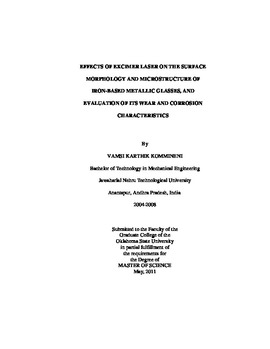| dc.contributor.advisor | Harimkar, Sandip P. | |
| dc.contributor.advisor | Komanduri, Ranga | |
| dc.contributor.author | Kommineni, Vamsi Karthik | |
| dc.date.accessioned | 2014-04-17T19:52:46Z | |
| dc.date.available | 2014-04-17T19:52:46Z | |
| dc.date.issued | 2011-05-01 | |
| dc.identifier.uri | https://hdl.handle.net/11244/9968 | |
| dc.description.abstract | Metallic Glasses are the new class of engineering materials having superior mechanical, tribological and corrosion properties when compared to conventional metals and alloys due to their disordered atomic structure. Fe-based metallic glasses belonging to this group of materials has potential applications in various industries due to its favorable properties. But, fabrication of these metallic glasses into micro, nano-scale components, and very fine intricate shapes with high dimensional accuracy cannot performed by traditional machining (lathe turning or drilling) methods. This motivated researchers to look for an alternative technique to process these materials with high dimensional accuracy. Excimer laser micromachining is a potential non-traditional machining technique where pulse length of 25 ns is used for micromachine material without any burrs, spatter etc. In this study, effect of excimer laser on the surface morphology and microstructure of these iron based metallic glasses was studied and evaluation of the corrosion resistance of the iron based metallic glass ribbon with heat treatment temperatures, wear behavior of the ribbon was conducted.Excimer laser induced craters were investigated by optical and scanning electron microscope (SEM) and laser interference microscope (MicroXam). The effects of pulse energy and number of pulses were studied in order to analyze the minimum pulse parameters required for the initiation of craters on the material surface. Morphological differences were observed in the crater surface compared with the surrounding area. Even change in the phase of material from amorphous structure to the crystalline structure was observed in these craters. The significance of this investigation is that ablation process in the excimer laser is not limited to direct solid-vapor transition, but also involves the substrate heating and change in microstructure due to thermal properties of the material. Increase in the corrosion resistance of the metallic glass ribbon was observed with the annealing temperature due to structural relaxation and variation of coefficient of friction in the range of 0.3-0.5 was observed for metallic glass ribbon during wear testing. | |
| dc.format | application/pdf | |
| dc.language | en_US | |
| dc.publisher | Oklahoma State University | |
| dc.rights | Copyright is held by the author who has granted the Oklahoma State University Library the non-exclusive right to share this material in its institutional repository. Contact Digital Library Services at lib-dls@okstate.edu or 405-744-9161 for the permission policy on the use, reproduction or distribution of this material. | |
| dc.title | Effects of Excimer Laser on the Surface Morphology and Microstructure of Iron-based Metallic Glasses, and Evaluation of Its Wear and Corrosion Characteristics | |
| dc.type | text | |
| dc.contributor.committeeMember | Bukkapatnam, Satish T.S | |
| osu.filename | Kommineni_okstate_0664M_11286.pdf | |
| osu.college | Engineering, Architecture, and Technology | |
| osu.accesstype | Open Access | |
| dc.description.department | Mechanical & Aerospace Engineering | |
| dc.type.genre | Thesis | |
| dc.subject.keywords | corrosion resistance | |
| dc.subject.keywords | excimer laser | |
| dc.subject.keywords | iron-based metallic glasses | |
| dc.subject.keywords | micromachining | |
| dc.subject.keywords | wear resistance | |
| dc.subject.keywords | x-ray diffraction | |
